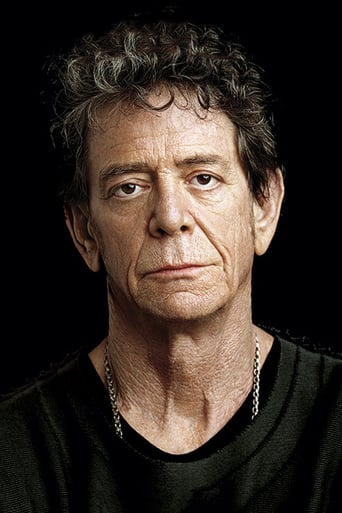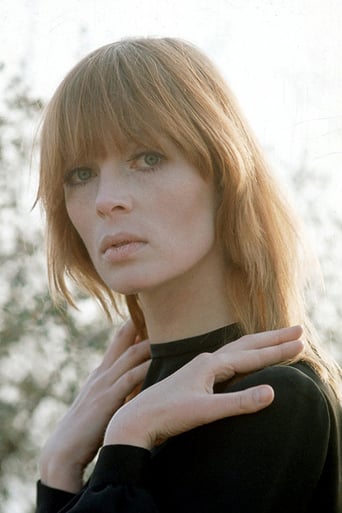

The Velvet Underground and Nico: A Symphony of Sound (1966)
The film depicts a rehearsal of The Velvet Underground including Nico, and is essentially one long loose improvisation.
Watch Trailer
Cast


Reviews
The first thing you must, must, MUST know if you are a Velvet fan- as I've been becoming over the past couple of years- is that this is the earliest period, their starting point with Nico, the Swedish model-singer-actress-what-have-you and that Warhol's participation was more as a booking agent and producer. It was "his" band the way that The Sex Pistols were Malcolm McLaren's group, which is to say not really. Sure he 'produced' the group's first banana-covered album (ho-ho), but the band arguably really hit their stride once they left Warhol, specifically with their final album (albeit without John Cale) titled Loaded. When they were with Warhol, however, they were still extremely experimental, and doing long-ass jams in a similar way as the Grateful Dead would do later: so long as jams that you would need Raoul Duke's whole carload of psychedelics to get by. And Warhol's "Film" (must use quotes here for justification) is not them performing some of their more well-known songs from the debut LP like 'Heroin' or 'Venus in Furs', or even one of their best songs 'Femme Fatale'. No no no, this is one of the jams (there is a track I believe on that first LP like that, only that was cut way down due to the constraints of an LP at the time). And Warhol and his camerman Paul "Flesh for Frankenstein/Dracula/etc" Morrissey, decided to document this auspicious occasion of their jamming out.And... what the (bleep) is this? I really have to wonder what Warhol's intention was here. As a document of a performance, as a "concert movie" it's all over the place, a total mixed bag of nuts. The biggest problem is an inconsistency with what to do with the camera. When Warhol/Morrissey keep the lens focused on a face or a full person or an instrument, hell even that cute little kid that Nico's got there, it's actually kind of interesting. Kind of. At least you can see some raw attitude in those moments of momentary stillness on a person or an instrument. And even at first the experiment of zooming in and out on faces and roaming around works. Kind of.But this is an hour-long jam, and the camera-work continues to go through its motions for a full hour. An hour of a Wayne's World intro-style EXTREME CLOSE-UP can be annoying as all hell after a while. Such as for an hour. And this doesn't count the out-of-focus angles as Morrissey tries to hone in on the band members, or sometimes just wanders off (later in the film the Fuzz comes to break up the distorted-rock commotion, but nobody can hear the cops even after the band stops so the documentary aspect is also total garbage). I have to think that it was a camera test, that maybe Morrissey was still a novice at cinematography and decided to test out his lens and tri-pod and pans and zooms and the lighting (which also goes in and out) on a performance at the "Factory" of the Velvets and Nico just doing their thing.One of the things Warhol was known for was for trying to make an audience feel bored and empty, which he thought was "good" somehow. "Because the more you look at the same exact thing, the more the meaning goes away, and the better and emptier you feel." (hey, his words, not mine) This isn't a case like Empire where one looks at the same image non-stop- or doesn't, as case might be- this is for all intents and purposes and document of the band in its time and place. Who knows, maybe for its time and place it was all so innovative to do such crazy things with a camera (like zoom-in, zoom-out, zoom-IN, zoom-in, focus-in, focus-out). It's like camera aerobics or something. For some it might be captivating - or if it's projected on a wall at a party and one only has to glance at it for short bursts while talking with friends. Maybe that was its reason for being.It doesn't help that the jam, as good as the musicians are at it (save for Nico who doesn't have much to do except to play maracas and at one point try some weird slide crap on a guitar that no one can hear), is so long and repetitive that it, too, loses its meaning in the miasma of the camera style. I should also note there are no edits at all- hey, who needs a flatbed when it can be all in-camera, man? To be sure, there are moments where the band picks up and makes it rock a bit, and a lot of this, ironically, comes in the last ten minutes when one of the guitarists steps away (I forget which as Lou Reed is the one given the most screen time, maybe due to proximity or his "cool" detached manner), and a violin player comes in. I suppose if you love a good, long jam, this is at least musically (when the sound doesn't DIP OUT, argh), it's enjoyable experimental/alternative listening.But as a movie of any kind of sort outside of a test or an experiment, it's a mess. I have to wonder of Warhol and Morrissey were just f***ing with people with this. Who could they show it to outside of little underground cliques or the slavish-adoration at the Factory? Maybe... that was enough for him. I also wonder if the intention was to bore or to get an actual emotional reaction? Perhaps the worst thing one could say to Warhol after watching it is that it was 'great' and made one feel something positive. It's an assault on the senses, and even as a rock and roller it goes too far and becomes dated in its anti-conventional style. It both bored and annoyed me. Guess that's a win for the 15-minute dude, eh?
I believe this film has some good things going for it, but within narrow parameters. So I will try to define those, as I see them, and you can decide to make the effort to see it yourself (or not).The screening I went to was greatly enhanced (in my opinion) by an introduction by Nico's biographer, who had also interviewed everybody appearing in the film. He explained that, when Warhol had been persuaded to take on the management of a nightclub and a rock band (that band being the Velvet Underground), one of the first things he did was get Nico onboard as a lead singer. Another thing he did was decide to have some film projected behind the band as they were performing onstage. To that end, he filmed them jamming vanilla footage of about seventy minutes. This is what this film was intended for.Now it will appeal to die-hard Velvet Underground fans cos if you are a fan you can never get enough of your favourite band. But casual listeners might not be quite so thrilled. You probably know a track called Sister Ray - this is a song by the band that has a few opening lyrics and then a long (instrumental) jam session. Well, if you were to cut out the lyrics and extended the jam for over an hour that's more or less what you've got here. No famous songs. No-one sings in it. But the Velvet Underground brand of jamming can get quite hypnotic. If you're in the mood (with or without drugs) you can probably dig it and really get into it.A second group it might appeal to is those people who are interested in film history either professionally or from a deep interest in film. If you think of the original remit (a backing film for a live performance) and think how much money and techno-wizardry would probably be expended on that today, and then look at this . . . Well I think you might agree that it is very effective at very little cost. Watching it in the originally intended setting would be exceedingly cool. Much better than a film of them doing specific tracks (which might clash with the onstage stuff) or something technically complicated (which would possibly distract). It was a good idea that could perhaps usefully be employed by band promoters today. It gives a whole new dimension to the idea of a music video, and a very simple one at that.A third group it will appeal to is dedicated Warhol fans and historians. How often do you get a chance to glimpse inside one of his workplaces? This film is shot in his first 'Factory' and is a nice down-and-dirty view, complete with police walking in towards the end to get them to turn the noise down (following complaints from neighbours). You can have fun spotting the various personalities and also maybe (as I did) comparing the camera techniques with those used in Chelsea Girls.I don't see it really appealing to anyone else, but I may have missed something. At any rate, this is minimalist film at its best, exploring technique in the 60's when there was so much waiting to be explored and Warhol was determined to explore (and exploit) it. I admired and enjoyed it. A lot of people didn't.
It's the Velvet Underground in 1966 so it would be difficult to make this bad. Pretty much the only way it could be ruined is if the cameraman zoomed in and out rapidly for 10 minutes... 20 minutes... 30 minutes... which, in fact, is the case. It's absolutely nauseating. While this might not bother some, it certainly bothered me.I guess what the cameraman was trying to do was treat the camera like it was an instrument. The other effects don't detract from this document, and the zoom wouldn't even be that bad if it was used a little more sparingly. On occasions, though, I really wish the camera was strictly used as a means to record this moment in time. John Cale plays something really wicked looking at one point, but you never really get a good look at it with all the zooming in and out and the tendency to not be focusing on what you want to see.It is still a film worth seeing for any Velvet Underground fan, and if you're a fan of Warhol's films, well, I guess you're used to things that are difficult to watch, so go for it. I definitely understand why this isn't commercially available. I'm glad I saw it, but I wouldn't be disappointed if I never saw it again.
I just recently saw a film print of this for the first time at the Brooklyn Academy of Music's Warhol retrospective a few weeks ago and was floored. If you are an artist or a musician, or both, then this is a particularly important film to see. It exists as the perfect time-capsule of 1966 in the Warhol Factory and completely lacks pretension. Even though it's original intention was to be wall paper (un-edited, moving images of The Velvet Underground, projected onto themselves as they actually played live), it still managed to take me though just about my entire range of emotions. Throughout the course of the film I thought about life, death, art, love, sex, and nearly everything in between. If you are expecting a concert film, think again...If you are lucky enough to find it, watch it with an open mind.




